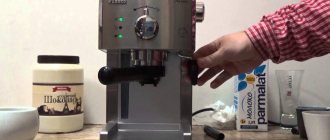Cappuccino only seems like a simple mixture of espresso and milk. The cooking process, the quality of the ingredients, and even the utensils are important. Every lover of the Italian drink can make cappuccino in a coffee machine. But to make it as tasty as in coffee shops, you need to know all the nuances of this process and take into account even the most insignificant details.
Cooking conditions
To brew cappuccino at home in a coffee machine, you should take into account a number of subtleties. You need to take a responsible approach to choosing milk and properly prepare the dishes. The easiest way to make a drink is in coffee machines with an automatic cappuccino maker. More budget models are equipped with a device for manually preparing cappuccino. The most popular non-commercial devices are produced by Delonghi, Philips and Bosch.
Milk for cappuccino
There are several requirements for this component:
- Fat content. A milk cap will not work if a low-fat product is used. The desired result can be achieved with a fat content of at least 3.5%.
- Protein concentration , which directly affects the density and tenderness of the foam. The required structure is achieved when its content is in the range of 2.8–3.5. Only when using high-protein milk will you get large, dry bubbles that create an airy effect.
- Initial temperature. Begin beating the cold milk product (3–5 degrees). Until it reaches the critical point of 75 degrees, there will be time to correct errors. If the temperature is higher, an uncharacteristic taste of boiled milk will appear for the drink.
It is strictly forbidden to use protein-free, powdered, stale milk.
Dishes
To get a real cappuccino, you need to select and prepare the dishes correctly. When starting to prepare cappuccino in a coffee machine, take into account the following points:
- the utensils for preparing and serving the drink are heated to 40 degrees;
- The presence of moisture on containers and condensation in the pitcher is unacceptable;
- It is recommended to use clear glass or ceramic cups for serving.
How to use a cappuccino maker
The process of preparing cappuccino in a capsule coffee maker depends on the type of cappuccino maker. If it is automatic, just place the container with milk in the unit and turn on the appropriate mode. The foam will flow into the cup of espresso on its own.
To prepare a drink in a simpler coffee machine, you need to figure out how to use a manual cappuccino maker:
- The device is heated for half an hour, releasing steam from the steam tube in advance.
- Milk is poured into the container. Its level should be approximately a centimeter below the spout. As you beat, it will increase in volume.
- The tip of the cappuccino maker is placed at the bottom of the container.
- Turn on the steam and slowly lift the tip up.
- Continue this process until foam forms.
These steps are suitable for a cappuccino maker equipped with a panarello nozzle.
Let's do without household appliances and make excellent foam
In the absence of technical assistants, the French press will be the best lifesaver, or rather “beater-cone.” This simple device will make foam that is not inferior in quality and durability to that whipped by a mechanism. The process will take a maximum of a minute.
Fill the French press flask one third with warm (70°) milk, lower the piston and vigorously perform up and down movements for 40 seconds. The volume of liquid will increase very quickly, the foam will turn out beautiful, with small bubbles. Place it on top of your coffee before it cools down.
Don’t be discouraged if you don’t have a French press in your kitchen. A metal whisk for beating eggs is found in every kitchen. Pour warm milk into a bowl and make foam by vigorous whisking.
Yes, we can do without a whisk. Let's take a glass jar, pour milk into it, close the lid tightly and call the strongest and freest member of the family for help. Skillful women's hands can also cope with whipping in a jar. You need to fill it 1/3, because the milk will increase in volume. It will take a minute to a minute and a half to foam.
The foam obtained manually using a whisk or by shaking the jar will not be as finely bubbled and dense as that from a cappuccino maker. But it will suitably decorate a classic cappuccino cocktail, especially if combined with good quality coffee.
How to make cappuccino in a coffee machine
In order for the preparation of cappuccino in a Delonghi or other brand coffee machine to be successful, you need to choose the right proportions. Coffee takes up about one-third of the cup. The rest of the volume is filled with whipped cream.
The ideal drink can be obtained if the following requirements are met:
- Espresso is brewed separately.
- Whip the milk so that a large amount of foam is obtained. There shouldn't be any milk in the cappuccino itself. Only foam is added.
- Ideally, espresso should be prepared at the same time as milk is frothed. In this case, the components are connected when they are heated to the same temperature.
A properly prepared cappuccino has the following characteristics:
- if the foam is pushed away with the tip of a spoon, it will return to its original position and will not lose its integrity;
- the foam covers the espresso with a dense layer and does not pile up;
- absence of pronounced bitterness and sourness, which indicate the use of low-quality coffee or incorrectly selected proportions.
Caring for your Delongi coffee machine with cappuccino maker
If you strictly follow the instructions for the Delonghi Cappuccino coffee machine, the device will work properly and serve the user for a long time.
An important condition is regular cleaning of the components. Do not use alcohol solutions or detergents with an abrasive texture for this purpose.
Care instructions:
- The coffee grounds container must be emptied when the corresponding message appears on the display.
- It is recommended to empty the condensate tray when the indicator goes behind the cup tray.
- Clean the inside of the machine, the water tank and the funnel for pouring coffee monthly, and the infuser - 2 times a month.
- Residues from milk in the container should be removed after each use.
Do not wash the device under the tap or immerse it entirely in water. Maintenance is carried out when it is unplugged.
To clean the cappuccino maker in the Delonghi coffee machine, you need to disconnect it from the nut and remove it from the water or steam supply tube. The hinge part must be disassembled, the tube and pin removed. Rinse the components under running water, reassemble in reverse order, reinstall and connect the tube.
The need to clean the cappuccino maker in a Delonghi coffee machine arises regularly.
Cleaning the filter
After preparing 250-300 cups of coffee, it is worth cleaning the filter in the Delonghi Cappuccino coffee machine. It is removed, the inside is cleaned by hand, and washed under hot water. If necessary, a brush can be used. The filter openings must be clean. Contaminants are removed with a sharp object.
Descaling
The length of time the coffee maker can operate without descaling depends on the hardness of the water. A notification will appear on the coffee machine display. To clean, use a DeLonghi decalcifier; vinegar-based products are not suitable. Regular decalcification helps extend the life of the machine.
To clean, you need to turn on the device and select the descaling program in the menu. Pour the decalcifier solution in the required proportion into a water container and place it under the supply tube. Start the process.
Safety tips for use
It is necessary to use the device without forgetting the safety rules. All actions are carried out only with dry hands. If the cable or plug is damaged or there are problems with the operation of the device, you need to seek repairs. Children should not use the coffee machine on their own; adult supervision is required.
Source
Cappuccino recipes
There is only one recipe for making cappuccino - the classic one. True, if desired, it can be supplemented with other components. Due to this, it is possible to obtain a new drink each time, differing in taste and aroma.
Classic recipe
For preparation you will need the following ingredients:
- coffee beans;
- chilled milk;
- sugar;
- liquor.
Actions are performed in stages:
- The grains are poured into a grinder and ground.
- Ground coffee is poured into a holder.
- The cup in which the coffee will be placed is heated.
- Turn on the unit and wait for the coffee to be prepared.
- Leave the container with espresso.
- Check the steam supply.
- Milk is poured into a special container.
- Lower the cappuccino maker into it at an angle of about 45 degrees.
- Beat the product until the volume doubles.
- Carefully pour the resulting milk foam into a cup of espresso.
- Add sugar and liqueur.
Egg-vanilla cappuccino
To obtain the original drink you will need the following components:
- Arabica coffee;
- egg yolk;
- a couple of tablespoons of milk;
- a couple of teaspoons of powdered sugar;
- a pinch of vanillin;
- chocolate.
The recipe requires the following steps:
- The grains are crushed.
- Espresso is prepared using the classic method.
- In a separate container, mix the egg yolk with milk, vanilla and powdered sugar.
- The resulting mass is whipped with a cappuccino maker until a dense foam is obtained.
- Spread the resulting foam on top of the prepared espresso.
- Decorate the resulting drink with grated chocolate in advance. They are very carefully sprinkled with egg-milk foam.
History of espresso coffee
Strong black coffee is the eternal love of all residents of the Mediterranean coast. But until the 20th century, the drink was prepared only in cezves (Turks), and coffee shop visitors had to wait too long for their order. Therefore, when the Milanese engineer Luigi Bezzera invented the coffee machine in 1901, it immediately became clear that the device had a great future. Already in 1903, entrepreneur Desiderio Pavoni acquired a license and in 1905 began producing Pavoni coffee machines.
The world's first coffee machine by Luigi Bezzera
The novelty delighted the public: now it took only half a minute to prepare coffee, so the name espresso was well deserved. Even before the war, the fashion for coffee machines spread to Italy and France. In 1927, the first coffee machine appeared in one of the bars in New York.
But there were some dissatisfied people. The fact is that in the model of coffee machine invented by Bezzera, the particles of ground coffee overheated, the taste of espresso lost its sophistication, and the tones of burnt beans were felt in it.
The shortcoming was corrected by Milanese bartender Achille Gaggia, who proposed a completely different technology. In the Gaggia semi-automatic coffee maker, pressure was created by a stream of hot water supplied under strong pressure. Since the water temperature in such a coffee maker is below +100 °C, the aroma of the drink is fully revealed, but there is no smell of burnt beans.
The economic situation in Italy after the war was extremely difficult, which is why many residents emigrated to English-speaking countries: the USA, Canada, Australia. In cafes and bars that Italian emigrants opened in foreign lands, they always served espresso coffee. As a result, already in the mid-60s of the last century, the drink gained popularity on all continents. It is loved even in conservative Asian countries, although there they drink espresso chilled, mixed with ice.
Temperature and drink delivery
It’s not enough to prepare a delicious cappuccino in a coffee machine, you need to serve it correctly. You should drink the drink slowly, straight with foam. For serving, use heated thick-walled cups with a volume of 210 ml, made of ceramics or glass. The classic serving option involves the use of special containers called tazza. They are shaped like a bowl with a handle.
The ideal temperature for this drink is considered to be between 60–65 degrees, which allows you to feel all the notes of taste.
It is unacceptable to serve cappuccino whose temperature exceeds 70 degrees. Fresh pastries are considered the best addition to it.
The coffee machine can prepare a variety of drinks. Cappuccino is no exception. To obtain a delicate taste, you just need to take into account a few important points. By following the rules and preparation techniques, you will be able to enjoy an exquisite drink that is not inferior to the one prepared by professionals in coffee shops.











